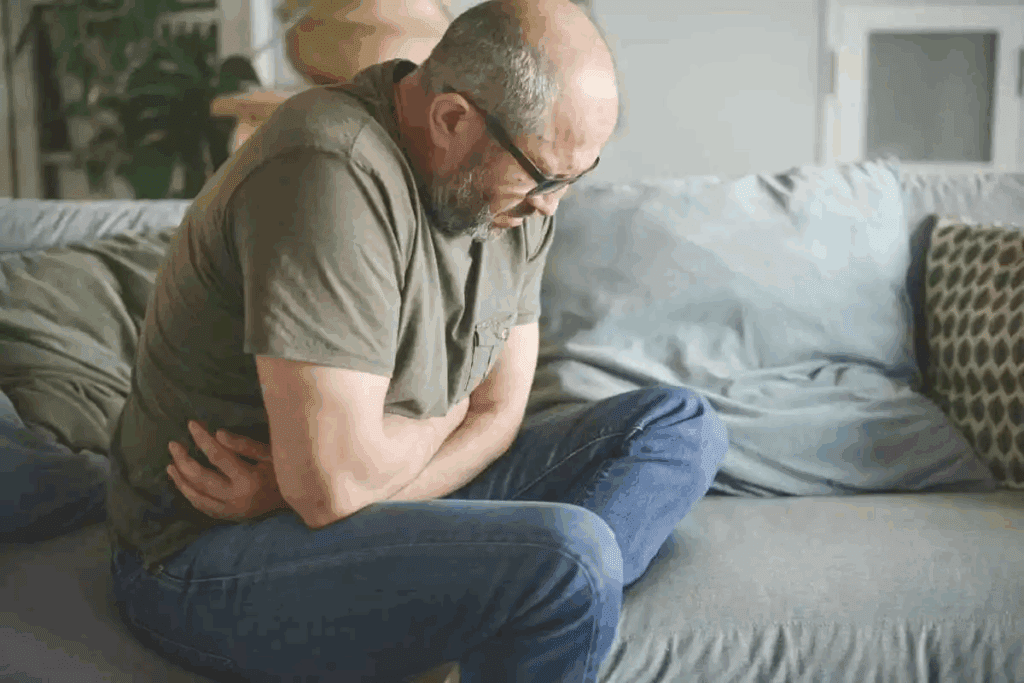Last Updated on November 26, 2025 by Bilal Hasdemir

Endoscopic Retrograde Cholangiopancreatography (ERCP) is a cutting-edge medical procedure that has transformed the way doctors diagnose and treat conditions affecting the biliary and pancreatic ducts.
Cholelithiasis, or gallstones, can cause serious complications such as bile duct blockages and infections. The cholelithiasis ERCP procedure plays a vital role in identifying and treating these issues effectively.
By combining endoscopy and fluoroscopy, cholelithiasis ERCP allows doctors to view the bile and pancreatic ducts in real time. This advanced approach enables precise diagnosis and treatment, helping patients recover faster and avoid further complications.

ERCP is a key method for managing cholelithiasis. It uses endoscopy and fluoroscopy to check and treat bile and pancreatic ducts. This makes ERCP very useful in gastroenterology.
Gallstones can block the bile ducts, leading to serious problems. It’s important to understand how these stones block the ducts and affect the biliary system.
Gallstones in the bile ducts can cause:
ERCP is used in several situations, like when bile duct stones block the flow. It’s chosen after a detailed diagnostic check.
Key reasons for using ERCP include:
ERCP has many benefits over traditional cholangiography. It can do both diagnosis and treatment at the same time. This means fewer procedures and faster recovery for patients.
The benefits of ERCP are:

Getting ready for an ERCP is key to its success. A detailed check-up helps spot risks and gets the patient ready for the test.
Patients get lab tests and imaging before an ERCP. Laboratory tests include blood counts, liver tests, and clotting tests. Imaging studies like ultrasound or CT scans show the bile ducts and look for gallstones.
“A thorough pre-procedure evaluation is key to reduce risks and ensure ERCP success,” say GI experts.
Getting consent and educating patients are important steps. They need to know about the ERCP, its benefits, risks, and other options. This includes talking about the procedure, answering questions, and getting consent.
Choosing the right anesthesia is also important. The type depends on the patient’s health, the procedure’s complexity, and the doctor’s choice. Conscious sedation or general anesthesia are used to keep the patient comfortable.
“The anesthesia choice for ERCP should match the patient’s needs and the procedure’s needs.”
Having the right ERCP equipment and room setup is key for a successful procedure. The ERCP suite needs top-notch endoscopic tools, fluoroscopy, and accessories for treatments. This ensures the procedure is both safe and effective.
Choosing the right endoscopic gear is essential for a good ERCP. You need a duodenoscope that’s flexible and has great vision. It should have a high-quality camera and enough space for tools.
The equipment must also work well with the fluoroscopy system for live images. High-quality monitors for both endoscopy and fluoroscopy are vital for clear views.
Fluoroscopy is a key part of ERCP, giving real-time X-ray images to guide the procedure. The fluoroscopy system needs to show clear images of the ducts. Adjusting the X-ray beam and positioning the patient correctly are important steps.
Fluoroscopy helps with precise cannulation and stone removal during ERCP. It’s important to keep radiation exposure low for the patient and staff. This is done by using shields and following safety rules.
There are many accessories for ERCP treatments, like sphincterotomes, balloons, baskets, and stents. The right tool depends on the problem, like the size and location of gallstones.
Sphincterotomes help with sphincterotomy for gallstone removal. Balloons and baskets are for stone extraction. Stents keep ducts open in cases of blockage.
For ERCP procedures to work well, it’s key to position the patient right and navigate the endoscope carefully. These steps help reach the biliary and pancreatic ducts.
Getting the patient in the right position is important for their comfort and safety. They are usually placed in a prone position on the table. This makes breathing easier and lowers the chance of aspiration.
The prone position also helps control the endoscope better. It makes seeing the duodenum clearer.
To get the best position, the patient’s left arm is placed behind their back. The right arm goes alongside their body or on an armrest. This keeps the patient stable during the procedure.
The next step is to insert and guide the endoscope to the duodenum. A duodenoscope, a special endoscope, is put through the mouth. It goes through the esophagus and stomach into the duodenum.
The endoscopist must be careful not to hurt the patient. They use torque, push, and pull maneuvers to move the scope. Fluoroscopy helps confirm the endoscope’s position.
Once in the duodenum, finding the Ampulla of Vater is the main goal. It’s where bile and pancreatic ducts meet the duodenum. It looks like a small nipple on the duodenum’s wall.
Finding the ampulla is vital for the ERCP’s success. The endoscopist uses different methods to locate and access it. Seeing the ampulla clearly is essential for the procedure’s success.
Biliary cannulation is key in ERCP procedures. It helps diagnose and treat biliary issues. The method involves guiding the endoscope to the ampulla of Vater and entering the biliary tree.
Most ERCP procedures use standard cannulation techniques. The standard cannulation approach uses a sphincterotome or cannula to reach the common bile duct. The choice depends on the operator’s skill and the patient’s body.
The guidewire-assisted cannulation method is popular for its success and lower pancreatitis risk. It involves using a guidewire to guide the cannula or sphincterotome into the bile duct.
When standard methods fail, difficult cannulation strategies are used. These include precut sphincterotomy or needle-knife sphincterotomy to access the bile duct.
The double-guidewire technique is another approach. It involves leaving a guidewire in the pancreatic duct while trying to access the bile duct. This stabilizes the papilla and aids in biliary access.
After successful cannulation, it’s vital to confirm ductal access. This ensures the cannula or sphincterotome is in the right place in the bile duct. It’s done with fluoroscopic imaging and contrast injection.
Fluoroscopy lets us see the guidewire or cannula in real-time in the biliary tree. Contrast injection outlines the ducts and checks for any leaks.
Good imaging is key for diagnosing and treating biliary and pancreatic duct problems during ERCP. The cholangiopancreatogram gives detailed pictures of these ducts. This helps doctors make the right diagnosis and plan treatments.
Choosing the right contrast medium is essential for clear images. Iodine-based contrast agents are often used because they are safe and work well. How the contrast medium is injected also matters a lot. A controlled injection prevents ducts from getting too full and makes sure the medium fills the needed areas.
Experts say, “A successful cholangiopancreatogram depends on the right contrast medium and precise imaging.” This shows how important careful technique is for success.
Fluoroscopic imaging lets doctors see the ducts in real time during ERCP. They need to know the normal anatomy and what changes might mean disease. Fluoroscopy helps guide tools to the right spot in the ducts, helping with diagnosis and treatment.
The main goal of a cholangiopancreatogram is to find gallstones and other duct problems. Gallstones show up as dark spots in the filled ducts. Knowing the size, location, and number of stones helps decide the best treatment. Doctors can also check for other duct issues, giving a full picture of the patient’s health.
“Finding gallstones and duct problems accurately is key for effective ERCP treatments,” showing how important good images are in making treatment plans.
By using advanced imaging and careful technique, doctors can improve ERCP results for patients with gallstones.
Therapeutic ERCP interventions are key in treating gallstones and other biliary issues. The procedure uses different methods to remove stones, restore bile flow, and ease symptoms caused by blockages.
Sphincterotomy is a vital part of ERCP for gallstone removal. It involves cutting the sphincter of Oddi to help remove stones. There are two main sphincterotomy techniques: needle-knife and pull-type. The choice depends on the patient’s anatomy and the doctor’s preference.
After sphincterotomy, doctors use balloon and basket methods to remove stones. Balloon extraction inflates a balloon to grab stones. Basket extraction uses a wire basket to capture and remove stones.
For big stones that can’t be removed by usual methods, mechanical lithotripsy is used. This method breaks the stone into smaller pieces that can then be removed.
Mechanical lithotripsy is great for stones that are too big to pass through the bile duct or have caused a lot of blockage.
If stones can’t be fully removed, stent placement is considered. A stent is put in the bile duct to keep bile flowing and ease symptoms like jaundice.
ERCP’s therapeutic interventions have greatly improved gallstone management. They offer a less invasive option compared to traditional surgery. Understanding these techniques helps healthcare providers give better care and improve patient outcomes.
Advanced ERCP techniques are key in treating tough cholelithiasis cases. These advanced methods have changed how we handle complex biliary issues. They offer patients better, less invasive treatment options.
New imaging technologies have made ERCP procedures more precise. Tools like intraductal ultrasound (IDUS) and cholangioscopy give clear views of the biliary system. This helps doctors diagnose and treat complex cholelithiasis more accurately.
Using these advanced imaging tools in ERCP has improved stone removal rates. For example, cholangioscopy-guided lithotripsy lets doctors see stones as they break them up. This makes the procedure more effective.
There are special methods for breaking down big or hard-to-remove stones. Laser lithotripsy and mechanical lithotripsy are used to split stones into smaller pieces. These pieces can then be easily taken out.
ERCP is also used for cholecystitis and intrahepatic stones. For cholecystitis, ERCP-guided gallbladder drainage is an option for those who can’t have surgery. Intrahepatic stones are treated with percutaneous transhepatic cholangioscopy and ERCP-guided interventions.
Combining endoscopic and radiological techniques is a big step forward in treating complex biliary diseases. These methods use the best of both worlds to tackle tough cases.
For instance, rendezvous procedures mix ERCP with percutaneous transhepatic cholangiography (PTC). This helps get biliary access and remove stones in hard cases.
After an ERCP, care is key to avoid and handle problems. It’s important for a smooth recovery and to lower risks.
Right after ERCP, watch for bleeding, pancreatitis, or perforation. Vital signs are checked often. Look out for symptoms that might show a problem.
Post-anesthesia care unit (PACU) protocols help with recovery from sedation. They make sure patients are okay before they go home or to a ward.
ERCP can lead to pancreatitis, bleeding, cholangitis, and perforation. Spotting and treating these early is vital to avoid serious issues.
| Complication | Symptoms | Management |
| Pancreatitis | Abdominal pain, elevated pancreatic enzymes | Supportive care, pain management, possible stent placement |
| Bleeding | Hematemesis, melena, drop in hemoglobin | Endoscopic hemostasis, blood transfusion |
| Cholangitis | Fever, jaundice, abdominal pain | Antibiotics, biliary drainage |
Before leaving, patients get care tips, diet advice, and watch-out signs. Clear communication is key to make sure they understand their care plan and know when to get help.
Follow-up plans include check-ups for late complications and to see how the ERCP went. This might include tests and scans to check on the patient.
By focusing on post-ERCP care and managing complications, doctors can improve outcomes. This reduces risks from ercp for gallbladder stone procedures.
Improving ERCP results is key for treating cholelithiasis well. ERCP, or Endoscopic Retrograde Cholangiopancreatography, helps find and fix problems in the biliary and pancreatic ducts. This is important for cholelithiasis treatment.
It’s important for doctors to know how ERCP works and its role in treating cholelithiasis. By learning and using the right techniques, doctors can make sure patients get better and avoid problems.
For ERCP to work well for cholelithiasis, doctors need to do a lot of things right. They must carefully check the patient, use the right tools, and do the treatments well. This way, doctors can give patients the best care during ERCP.
As endoscopy gets better, doctors need to keep up with new ERCP methods and tools. This helps them give the best care to patients with cholelithiasis. Keeping up with these changes is important for good patient care.
ERCP is a medical procedure. It uses endoscopy and fluoroscopy to look at and treat problems in the biliary and pancreatic ducts.
ERCP helps find and treat gallstones that block the bile ducts. It also removes stones from the bile ducts.
ERCP does both imaging and treatments in one go. This makes it more efficient and effective for some biliary conditions.
Before ERCP, patients get lab tests, imaging, and education. They might also need anesthesia or sedation.
ERCP needs special endoscopic tools, fluoroscopy, and accessories like sphincterotomes and stone extraction balloons.
ERCP can cause pancreatitis, bleeding, infection, and perforation, among other complications.
After ERCP, care includes watching for complications, managing pain, and giving discharge instructions and follow-up plans.
Cholangiopancreatogram is a diagnostic imaging technique used in ERCP. It helps see the biliary and pancreatic ducts and find problems like gallstones.
Yes, ERCP can treat complex cholelithiasis cases. This includes using advanced techniques like mechanical lithotripsy and stent placement for large or intrahepatic stones.
ERCP is generally safe when done by experienced endoscopists. But, like any medical procedure, there are risks and possible complications.
Subscribe to our e-newsletter to stay informed about the latest innovations in the world of health and exclusive offers!